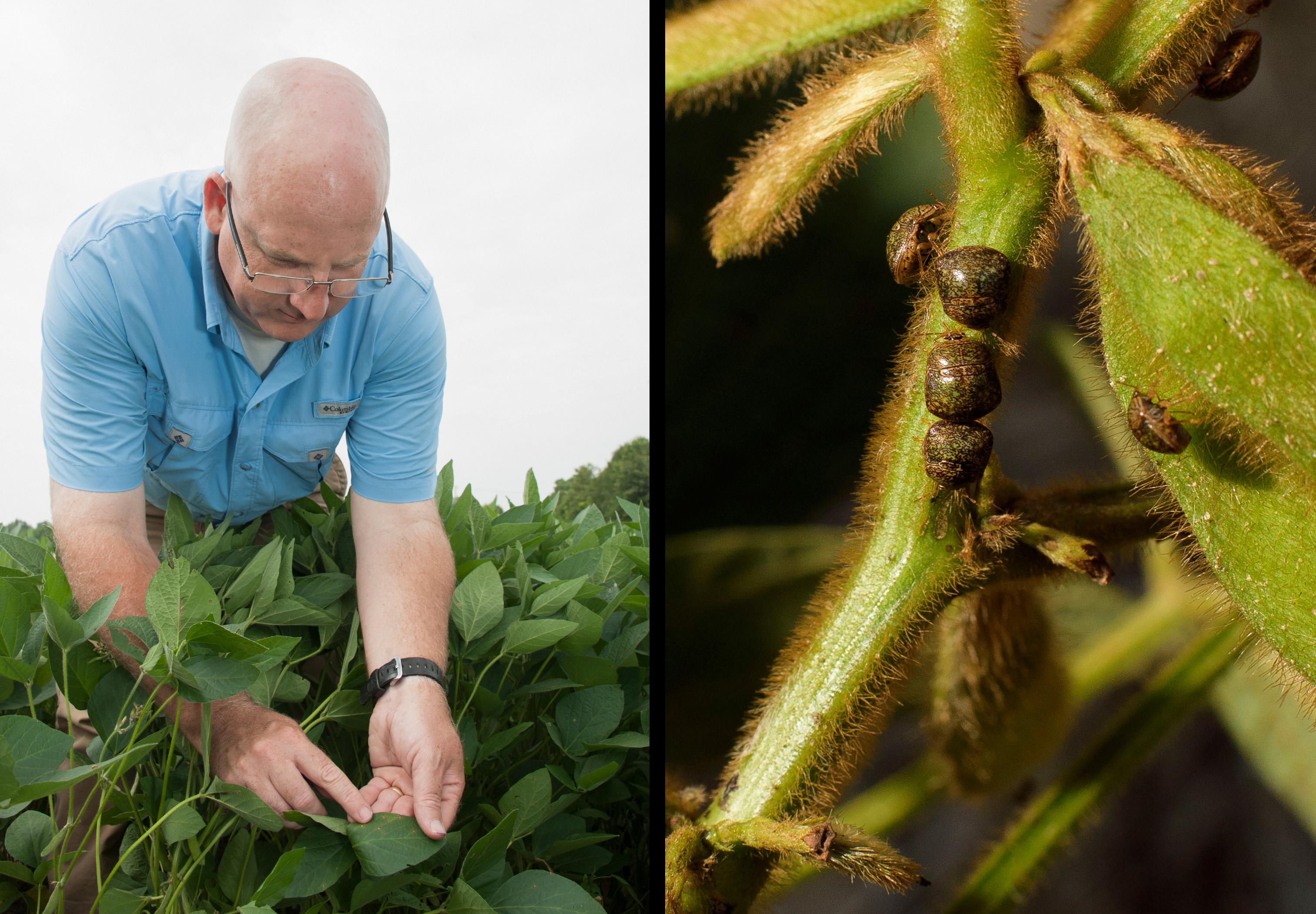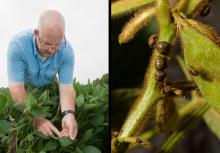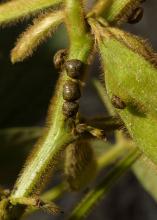Information Possibly Outdated
The information presented on this page was originally released on October 30, 2015. It may not be outdated, but please search our site for more current information. If you plan to quote or reference this information in a publication, please check with the Extension specialist or author before proceeding.
New insect, weed and disease threats challenge producers
STARKVILLE, Miss. -- Farmers know how to handle ongoing threats posed by insects, diseases, and weeds, but new threats continue to surface that keep them on high alert and change the way they operate.
Mississippi Agricultural and Forestry Experiment Station researchers and MSU Extension Service specialists work to monitor the arrival of new crop threats, determine the best way to address the problem, and pass on those recommendations to producers.
Insect pests …
Extension entomologist Angus Catchot is leading the charge against kudzu bugs in soybeans and sugarcane aphids in grain sorghum. Both entered the state in 2013, and their populations and impact are building.
“We probably didn’t treat more than 5,000 acres for kudzu bugs last year, and just 2,500 acres the year before,” Catchot said. “I’ve had numerous calls this spring about kudzu bugs in places we’ve not seen them before. Apparently they made a pretty big jump in numbers out of overwintering.”
Kudzu bugs overwinter in protected places, such as wooded areas, homes, and sheds. As they emerge in the spring, they head to wisteria, kudzu, or early-planted soybean fields.
Catchot said these insects are highly visible because their dark brown color makes them stand out on the green soybean plants. They don’t appear to cause much damage until their numbers get high.
Trey Bullock, a crop consultant with Bullock’s Ag Consulting in Hattiesburg, has been dealing with kudzu bugs. He said management decisions related to these insects are difficult.
“We had some really bad numbers last year, but we didn’t have yield loss,” Bullock said. “This year, we started out with probably the earliest beans planted in the state and for 100 to 150 yards around the borders of the fields, we had an average of nine or ten kudzu bugs per plant.
“With that many bugs on a plant, you’d think it would be wilted or something, but I saw nothing,” he said. “We made a decision not to treat, and when we came back and checked again, the population had declined significantly.”
Catchot said he expects kudzu bug numbers to make a big jump this year and reach high numbers. MSU researchers have already made recommendations on how to manage these pests.
The sugarcane aphid is a pest that makes a direct threat to yields in grain sorghum.
“We found sugarcane aphids in one county in 2013, and last year, they spread to every county that had grain sorghum,” Catchot said. “They are very damaging if not controlled, so we put a lot of effort into education, treatment thresholds, and what products to use for this pest.”
Another insect pest that looms on the horizon is the old world bollworm. It was recently discovered in Brazil and has been confirmed in Puerto Rico.
“It’s currently not in the U.S., but it seems to be making its way here,” Catchot said. “The question is when.”
At first glance, old world bollworm looks identical to the traditional bollworm found in soybeans and other crops. Treatment is possible, but the insect tends to be more tolerant of some insecticides typically used in soybeans to control pests.
“This insect will change the way we do things, and it will be important to stay on top of it,” he said.
Plant diseases …
The newest threats in both weeds and plant diseases come from those that have developed resistance to chemical treatments.
Tom Allen, a plant pathologist with MSU Extension and the Mississippi Agricultural and Forestry Experiment Station at MSU’s Delta Research and Extension Center in Stoneville, said fungicide-resistant frogeye leaf spot in soybeans has recently become a major problem.
“A graduate student conducted an extensive survey of the frogeye leaf spot fungal population in the state and determined that resistance to the most commonly used class of fungicides is already present in 73 of the state’s 82 counties,” Allen said. “When we started the project, we thought we might not find much resistance, but by the second year, we were concerned that we wouldn’t find any fields where the fungicide would still work.”
Mississippi producers typically plant high-yielding soybean varieties, which in some cases are more susceptible to frogeye leaf spot. The occurrence of fungicide resistance within the frogeye leaf spot fungal population likely occurred because it is common management practice to spray a strobilurin fungicide for late-season disease management at the R3–R4 growth stage as a preventive measure. Allen said that allowed frogeye leafspot to develop resistance to this fungicide class.
“There are other fungicide classes that manage this disease, and there are frogeye leafspot-resistant soybean varieties available, but they may not yield as well, so they’re not the preferred varieties,” he said. “We have to change some management practices, rely on resistant varieties, and apply alternative fungicide classes to help manage frogeye leaf spot in the future.”
A second disease problem Mississippi producers are facing is actually the resurgence of an old problem. Nematodes, nearly microscopic roundworms, have become a greater threat to cotton and soybeans because of continuous cropping practices. Nematodes prefer certain plants as hosts, and when one crop is planted continuously, it allows the parasite to flourish. Crop rotation introduces a different crop that the nematode population may not affect and can help by reducing nematode numbers.
“We don’t have enough folks taking soil samples and sending them to the diagnostic lab and then changing their overall management practices because of the particular nematode species or population numbers they have in their soil,” Allen said.
Weed problems …
Jason Bond, a weed scientist with the Mississippi Agricultural and Forestry Experiment Station and MSU Extension, said there are nine glyphosate-resistant weeds in Mississippi. The biggest problem by far is battling resistant Palmer amaranth in the summer and Italian ryegrass in the winter.
“We use paraquat to control any Palmer amaranth that has emerged and to control Italian ryegrass prior to planting our spring crops,” Bond said. “If we were to identify Palmer amaranth or Italian ryegrass that is resistant to paraquat, or Palmer amaranth that is resistant to Liberty, that would be a game changer.”
Extension agents work alongside producers and crop consultants year-round to identify new threats and manage crop conditions, and MSU researchers work to develop effective strategies to handle the challenge. Up-to-the minute crop information from MSU can be found online at http://www.mississippi-crops.com.











